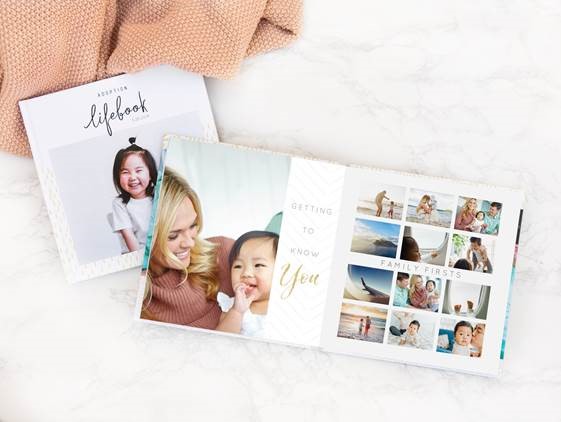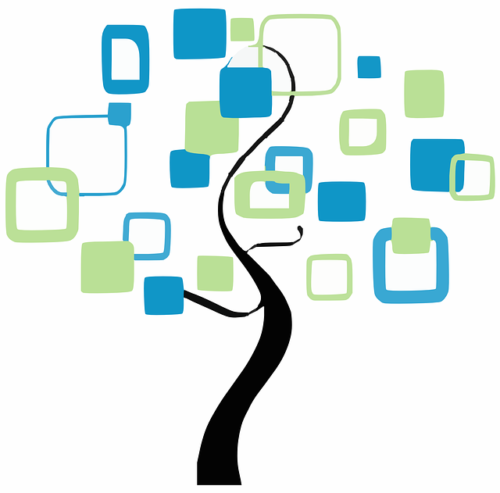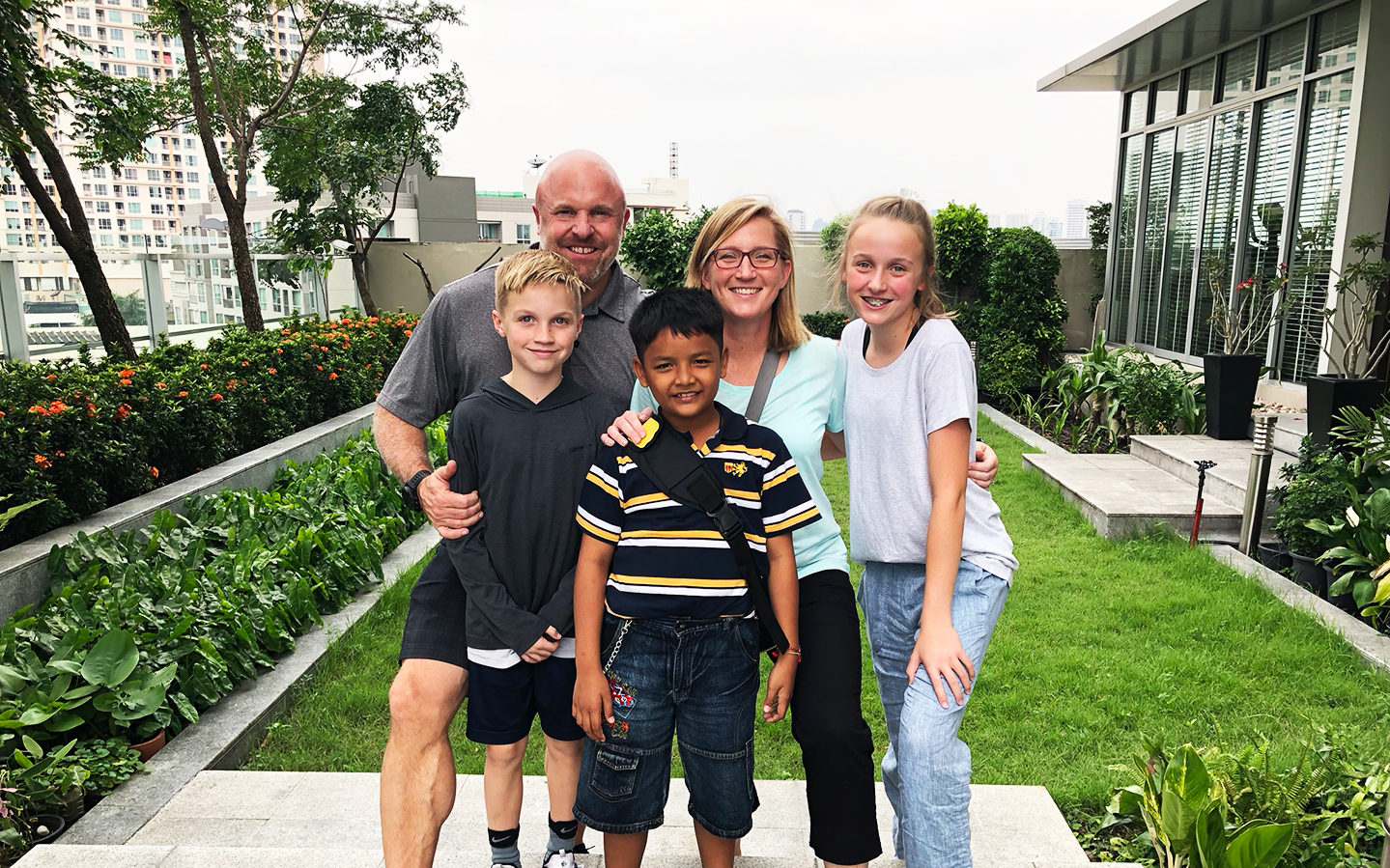Finding ways to craft our own personal narratives is an essential component of the lifelong process of healthy identity development.
The field of psychology calls this concept narrative identity, which is defined as the ‘internalized evolving story of the self that each person crafts to provide his or her life with a sense of purpose and unity’ (Adler, 2012, p.367). Scrapbooks, baby books and photo albums have historically been important tools in helping us piece together childhood memories and make sense of our pasts. They have weathered the storm of digitization by morphing into the online photobook industry. Photobooks give us a way to honor the events and people that have shaped us. And they still offer that wonderfully cathartic experience of turning to a page that illustrates a moment in our past — a past that someone has chosen to carefully preserve for us.
No matter how it happens, adoption always begins from an experience of separation and loss. Each adoptee also, always, has an important personal story (or many stories) that they need to learn and understand. Each adoption story might touch various cultures, races, faiths and family circumstances. And while there are almost certainly difficult parts, adoption stories also hold an essence of strength and resilience at their core. Along with most adoption professionals, I believe it is the right of every adoptee to have access to his or her own story, and for that story to be as transparent and detailed as possible. It is also the responsibility of the adoptive parents to initiate honest, age-appropriate discussions about their child’s history beginning as early in the placement as possible.
Whether placed as a baby or older, each adoptee will have gaps in time and memory that may never be filled. There will likely be questions that cannot be answered. And when a child’s past is sad, scary or traumatic, parents and adoption professionals alike are often challenged by how to honestly portray a child’s history. We want to focus on healing and resilience, so why would we bring something up that could re-traumatize a child or cause anxiety?
Claudia Jewett Jarratt, author of “Helping Children Cope With Separation and Loss,” explains it like this: “Unfortunately, such well-meaning avoidance in a helper leaves the child alone in his fantasies … and these are often more frightening, self-blaming, and damaging than the actual facts would have been.” Each adoptee has an important story that should be understood by the adoptee and honored by his or her family. This is a powerful way that we can help adopted children heal from trauma and grow into healthy adults.
Photobooks give us a way to honor the events and people that have shaped us. And they still offer that wonderfully cathartic experience of turning to a page that illustrates a moment in our past — a past that someone has chosen to carefully preserve for us.
So, how do we do this?
One easy step is to learn about lifebooks and life stories. Both exist to hold and honor an adoptee’s story. And, when used thoughtfully, both can be therapeutic catalysts towards healthy identity development. Each takes a different approach to honoring and sharing your child’s story. But they both have their own benefits, and a time and place to be used, which I’ll outline for you. There are many different ways to approach the process of creating a lifebook or life story for your child, so if my descriptions don’t draw you in, keep looking for something that does!
The Lifebook:
Most adoptive parents create lifebooks or adoption photobooks before or shortly after their child joins their family, but they can be done at any time. The books hold important information — usually lots of photos, descriptions of events and people, and sometimes documents. The traditional lifebook starts at birth and moves chronologically through a child’s life up to the time they come home to their adoptive family, not unlike a baby book. Adoptive parents often have pages about their adoption process, seeing their child’s photo for the first time, meeting for the first time, visiting with caregivers, etc. Some books hold important information about their child’s birth family and foster family or caregivers.
Since lifebooks are often shared with family and friends, be sure to carefully screen and edit the information for public consumption. This will help preserve your child’s history as his or her own until they are old enough to decide what parts to share and with whom.
An adoption photobook can be a great option for capturing an event or period in time, like your adoption trip or first year home with your child. They can also be used to help your child prepare for coming home by introducing your family, home and community. One of the biggest benefits of the lifebook is that it is fun and easy to complete, and there are many online services that help parents create them. Lifebooks do a nice job of capturing information in an eye-pleasing, cohesive way that can be enjoyed by many.
Creating a lifebook or adoption photobook is an excellent first step towards developing a therapeutic life story for your child. Because these are created from the parents’ perspective, think of them as an introduction to an important topic that will grow and change with your child. For an older child or a child with a complicated birth history (who is well established in an adoptive family), I recommend exploring life story work in addition to making a lifebook. The life story process can help a child build self-esteem, promote attachment and work through past trauma.
The Bottom Line On Lifebooks
I recommend lifebooks for a young child (younger than school age) and/or early in their time home with an adoptive family. These are especially helpful tools when you are trying to capture a specific event or timeline — like the adoption trip, the child’s time in foster care, etc. — or if you want something that you can share with others. Lifebooks can be conveniently designed online and tailored to meet your needs. Check out the mixbook.com resource at the end of the article for a special offer available to Holt families!
The Life Story:
Research has shown us that having a cohesive narrative of past experiences, specifically adverse ones, helps people heal from trauma and recover from PTSD symptoms (Adshead, 2012). Additionally, those who do not develop a cohesive understanding of their past experiences are less able to respond sensitively to their own children later in life (Kaniuk, Steele, & Hodges, 2004). By investing in opportunities to learn about our past, we can help our children create their own personal narratives — and it is well worth the effort!
The therapeutic life story uses activities and an approach that incorporates separation, loss, attachment and trauma in its design. Before diving into the tough stuff with your child, it allows you to engage in activities that highlight your child’s competencies and current relationships — building a foundation of safety and confidence. It is typically designed for children ages 4-12, depending on which specific approach you use, and it unfolds as a collaborative process with your child, led by you, the parent, as well as a therapist or social worker. You compile the book to limit the stress on your child, but your child is very much a part of its design and creation.
I’ve completed life story books with several children and found it to be beneficial to both the child and parents. A few years into an adoptive placement, the gravity of a child’s pre-adoption history and of the monumental life changes he or she has experienced tends to fade and parents often become focused on the challenging behaviors their child is presenting in the moment — which is what brings them to therapy. I have found that the life story process helps parents regain a sense of empathy for their child’s experience and an appreciation for the progress they have made together as a family.
For the first time, parents also get to see their adoption story illustrated from their child’s perspective. For those who are open to engaging in this process, it can be an empowering experience of learning, growth and healing for both parent and child.
The Bottom Line on The Life Story
The life story book is both a process and a product. The process is based on theories of attachment and loss and builds upon strengths and relationships to buffer the difficult parts. The experience of creating a life story with your child provides an opportunity for joining, reflecting on and honoring your child’s history. Life story work is life-long and does not end with the completion of the book. I like to think of the book as something tangible that an adoptee can carry with him or her throughout life. It can be re-visited, refined, added to, or revised — it is the adoptee’s story, after all. I received training in life story work a few years ago and have crafted life story books with a number of therapy clients. I can attest to how powerful and special the process of creating a life story book with a child can be.
Learning about how to help your child honor his or her story should be on every adoptive family’s to-do list. It is one of the most important research investments that a parent can make. With that, I send you on your way towards helping your child heal and grow, with a few helpful resources for you to check out below.
Marissa Robello, LMSW, CSWA | Director of Adoption, Colombia
Questions? Email me at [email protected].
Resources for Parents
Traditional Lifebook:
Lifebooks: Creating a Treasure for the Adopted Child Updated and Revised by Beth O’Malley, M.Ed
Adoption Learning Partners Webinar “Lifebooks”
Mixbook.com: Adoption lifebook /photobook preparation online
*Special offer for HOLT families: Create a beautiful adoption photo book that stands out from the rest and tell your unique story for 50% off with Mixbook.com. You’ll also get up to 40% off everything on the site including adoption announcement cards, invitations, home decor and prints, and more! Use code HOLT50 at checkout. Offer good through June 30, 2019. Click here
Therapeutic Life Story:
Excellent how-to books for parents and adoption professionals:
Life Story Books for Adopted Children: A Family-Friendly Approach by Joy Rees. Offers an excellent guide to how to structure the story and examples.
Life Story Work with Children Who are Fostered or Adopted … Creative Ideas and Activities by Katie Wrench, Lesley Naylor
For adoption professionals or scholars interested in learning more:
Life Story Therapy with Traumatized Children: A Model for Practice by Richard Rose, with foreword by Bruce D. Perry M.D., Ph.D.
Innovative Therapeutic Life Story Work Edited by Richard Rose, Forward by Deborah D. Gray
Sources (in addition to the books mentioned above):
Adler, J.M. (2012). Living into the story: agency and coherence longitudinal study of narrative identity development and mental health over the course of psychotherapy. Journal of personality and social psychology, 102(2), 367.
Adshead, G. (2012). Their dark materials: narratives and recovery in forensic practice. Royal College of Psychiatrists Publication Archives, available at rcpsych.ac.uk (accessed January 31, 2013).
Kaniuk, J., Steele, M., & Hodges, J. (2004) Report on longitudinal research project, exploring the development of attachments between older, hard-to-place children and their adopters of the first two years of placement. Adopting and Fostering, 28(2), 61-67.
Marissa Robello, LMSW, CSWA | Director of Adoption, Colombia



Thank you for this article, it has motivated me to get started with our life books